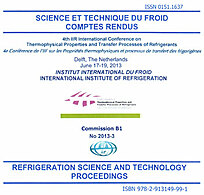
Document IIF
Comportement d'écoulement diphasique dans un tube lisse en épingle à cheveux.
Two phase flow behaviour in a smooth hairpin tube.
Numéro : pap. n. TP-030
Auteurs : DE KERPEL K., GROOF C. de, DREESEN M., et al.
Résumé
Fin-and-tube heat exchangers are often used as evaporators in HVAC&R systems. To increase the compactness, the tubes of these heat exchangers are folded up in a sequence of hairpin tubes. These hairpins consist of two straight tubes interconnected by a sharp U-bend. The working fluid will pass through several hairpin tubes while evaporating. The two-phase flow behaviour in the tubes will be influenced by the geometry of the bends and how the sequence of bends is built up. In this work the evolution of the two-phase flow behaviour downstream of a sharp return bend is studied. This is done by measuring the capacitance of the flow on several locations downstream of the return bend. Due to the difference in dielectric constant between the phases, the measured capacitance will vary depending on the amount of each phase present between the electrodes. Previous work has already shown that the flow behaviour can be characterized based on the capacitance signal of the flow. The refrigerant used in this study is R134a, the mass flux was varied between 150 and 450 kg/m²s and the vapour fraction varied between 0 and 1. It was observed that downstream of the return bend a significant effect on the flow regime was induced up to 10 tube diameters downstream of the bend.
Documents disponibles
Format PDF
Pages : 8 p.
Disponible
Prix public
20 €
Prix membre*
Gratuit
* meilleur tarif applicable selon le type d'adhésion (voir le détail des avantages des adhésions individuelles et collectives)
Détails
- Titre original : Two phase flow behaviour in a smooth hairpin tube.
- Identifiant de la fiche : 30008105
- Langues : Anglais
- Source : 4th IIR Conference on Thermophysical Properties and Transfer Processes of Refrigerants
- Date d'édition : 17/06/2013
Liens
Voir d'autres communications du même compte rendu (69)
Voir le compte rendu de la conférence
Indexation
-
Neutron imaging calibration to measure void fra...
- Auteurs : GEOGHEGAN P., BILHEUX H., SHARMA V., et al.
- Date : 16/08/2015
- Langues : Anglais
- Source : Proceedings of the 24th IIR International Congress of Refrigeration: Yokohama, Japan, August 16-22, 2015.
- Formats : PDF
Voir la fiche
-
Effect of inlet configuration on the two-phase ...
- Auteurs : KIM D. Y., KIM N. H., BYUN H. W., et al.
- Date : 07/06/2010
- Langues : Anglais
- Source : ACRA2010. Asian conference on refrigeration and air conditioning: Tokyo, Japan, June 7-9, 2010.
- Formats : PDF
Voir la fiche
-
Refrigerant-distribution characteristics of a h...
- Auteurs : ENDOH K.
- Date : 24/08/2019
- Langues : Anglais
- Source : Proceedings of the 25th IIR International Congress of Refrigeration: Montréal , Canada, August 24-30, 2019.
- Formats : PDF
Voir la fiche
-
Flow visualization of ammonia inside a gasketed...
- Auteurs : LEICHSENRING M., TAO X., INFANTE FERREIRA C., et al.
- Date : 24/08/2019
- Langues : Anglais
- Source : Proceedings of the 25th IIR International Congress of Refrigeration: Montréal , Canada, August 24-30, 2019.
- Formats : PDF
Voir la fiche
-
Experimental investigation of R290 during flow ...
- Auteurs : FRIES S., LUKE A.
- Date : 24/08/2019
- Langues : Anglais
- Source : Proceedings of the 25th IIR International Congress of Refrigeration: Montréal , Canada, August 24-30, 2019.
- Formats : PDF
Voir la fiche
